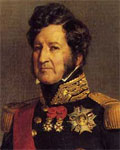 |
Louis-Philippe d'Orléans
b. 6 Oct 1773, Paris, France
d. 26 Aug 1850, Claremont House, near Esher, Surrey, England |
| Title: |
Lieutenant général du royaume (Lieutenant General of the Kingdom) |
| Term: |
31 Jul 1830 - 9 Aug 1830 |
| Chronology: |
30 Jul 1830, invited to accept the office of Lieutenant General of the Kingdom, resolution of the Chambre des députés (Chamber of Deputies), session of the Chamber, salle de Bois, jardin des Quatre colonnes, Palais-Bourbon, Paris [1] |
|
31 Jul 1830, accepted the functions of office, public ceremony, Palais-Royal, Paris [2] |
|
7 Aug 1830, throne of France declared vacant, duc d'Orléans is called to accept the crown; declaration of the Chamber of Deputies, passed at the Chamber session, salle de Bois, jardin des Quatre colonnes, Palais-Bourbon, Paris; Chambre des pairs (Chamber of Peers) passed a resolution of adhesion (7 Aug 1830) to the act of the Chamber of Deputies [1, pp. 173-175] |
|
9 Aug 1830, accepted the crown of France, swore an oath to observe the Charte constitutionelle (Constitutional Charter), joint meeting of the Chambers of Deputies and the Chamber of Peers, salle de Bois, jardin des Quatre colonnes, Palais-Bourbon, Paris [1, pp. 176-178] |
| Names/titles: |
Duc de Valois (duke of Valois) [from birth]; duc de Chartres (duke of Chartres) [from 18 Nov 1785]; duc d'Orléans (duke of Orléans) [from 6 Nov 1793]; after abdication (24 Feb 1848) used the cover incognito title comte de Neuilly |
|
Roi des français (King of the French) [9 Aug 1830 - 24 Feb 1848] (see details) |
| Biography: |
Eldest son of Louis-Philippe-Joseph duc de Chartres (duc d'Orléans 1785-1792, Philippe Égalité 1792-1793) and Louise-Marie-Adélaïde de Bourbon; was privately tutored; named colonel of dragoons (1785) at the age of 12; supported the Revolution and became a member of the Jacobin club (1790); joined the Army of the North; promoted to maréchal de camp (7 May 1792), lieutenant general (11 Sep 1792); followed General Dumouriez, who deserted to the Austrians (4 Apr 1793); living in Switzerland, taught at a college; immigrated to the United States (1796-1800); moved to England (1800-1809); married a daughter of the king of Sicily Ferdinando III and moved to Palermo (1809); returned to France during the First Restoration (1814); fled to England on the return of Napoléon I (1815); again took possession of the Orléans estates during the Second Restoration (1815); gradually assumed the leadership of liberal opposition; accepted the title of lieutenant general of the Kingdom (31 Jul 1830) to act as a temporary chief executive during the revolt against King Charles X; accepted the throne of France and was proclaimed King of the French (9 Apr 1830); was restricted in governing by the provisions of the revised Charte constitutionelle (published 14 Aug 1830); relied on the support of the upper bourgeoisie presented in the Chambre des députés (Chamber of Deputies) by two factions led by François Guizot and Adolphe Thiers; faced a number of uprisings, threatening to overthrow the Orléanist monarchy, including legitimist plots, workers' revolt in Lyon (1831) and attempts of Louis-Napoléon Bonaparte to stage a coup (1836, 1840); achieved relative stability and reconciliation of revolutionary ideas with traditional social order, but failed to unite the society in face of socialist agitation and demands for universal suffrage; was forced to abdicate (24 Feb 1848) as a result of popular insurrection in Paris; spent last two years of his life in England.
|
| Biographical sources: |
| |
| [1] |
Archives parlementaires - Série 2, 61:644. |
| [2] |
Archives parlementaires - Série 2, 61:646-647. |
| [2] |
A decree appointing Louis-Philippe as lieutenant général du royaume was signed by Charles X on 1 Sep 1830, but this appointment passed unnoticed as Charles' royal authority lost public recognition. [1, p. 168] |
| [3] |
La grande encyclopédie: inventaire raisonné des sciences, des lettres et des arts, ed. by Berthelot, Hartwig Derenbourg, F.-Camille Dreyfus... [et al.] (Paris: H. Lamirault, 1885-1902). |
|
Image: portrait by Franz Xaver Winterhalter (1839). |

